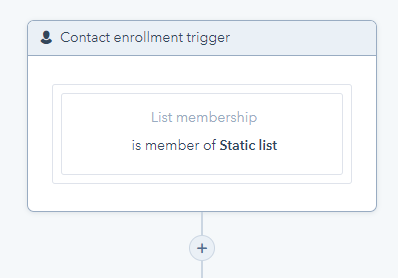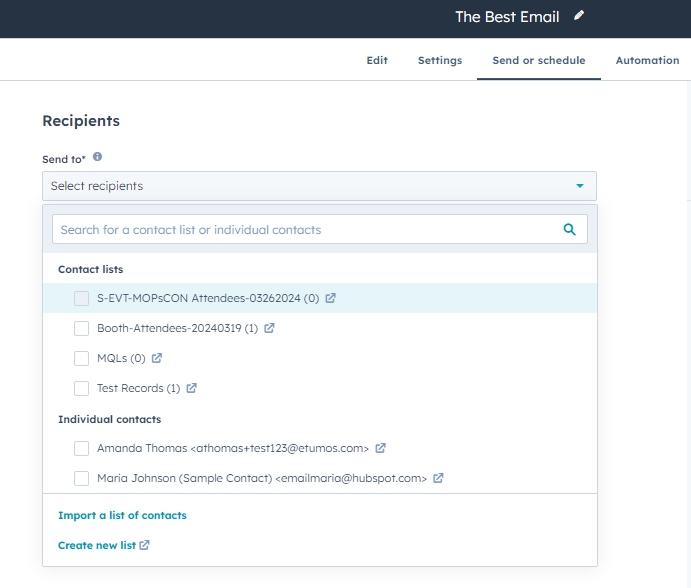HubSpot lists can be used to enroll people in a workflow, streamline task management among teams through automation, and enable the implementation of smart rules for customizing messages. To initiate email communication sends outside of a workflow, lists become imperative, whether they are active, static, or uploaded.
Let’s dive into how you can use different types of lists in HubSpot.
Active vs Static Lists
Active lists represent dynamic snapshots of the database, continually updated in real-time. Records are automatically included or excluded based on meeting specified criteria, ensuring the list’s relevance. For instance, active lists are aptly employed for recurring email distributions targeting Marketing Qualified Leads (MQLs).
Static lists offer a snapshot of the database at a specific point in time. Members are determined based on criteria set at the time of list creation, with the flexibility of manually adding or removing records. A typical scenario for utilizing static lists is capturing attendees of a particular event, providing a snapshot of engagement at a specific moment.
What Lists Should You Create in Hubspot?
Depending on your email marketing/nurture strategy, you will likely use these common list types:
Marketability
In the realm of targeted email marketing, the determination of a general marketable audience involves more than just ensuring that the recipients haven’t unsubscribed. Additional attributes play a crucial role in segmenting this audience effectively. By considering factors such as Partner status, Employee affiliation, Opt-In preferences, and more, marketers can refine their audience into specific segments. Leveraging a combination of default attributes provided by HubSpot, along with custom fields tailored to specific needs, you are able to create highly targeted marketability lists.
Lifecycle
Organizations can optimize their outreach by creating distinct active lists tailored to each lifecycle stage or segmented according to various buyer journey milestones. These lists can be leveraged within workflows, automatically triggering email communication when a record transitions to a designated stage, such as becoming an MQL.
Lists that are categorized more as buyer journey segmentations (more than one lifecycle stage) allow marketers to ensure the delivery of relevant content, aligning top-of-funnel prospects with introductory materials and bottom-of-funnel leads with more conversion-focused content, thereby enhancing engagement and nurturing prospects effectively.
Persona
A persona list involves compiling a targeted group of contacts based on detailed demographic, firmographic, and even behavioral characteristics to represent ideal customer profiles. This entails integrating a variety of criteria, including job function, role, and level, as well as industry specifics, to ensure the list aligns closely with the intended persona.
When building these lists, you can leverage both attributes captured from form fills and enriched data sourced from third-party integrations. Persona lists can be leveraged within email sends and workflows to increase effectiveness of marketing strategies and increase conversions.
Customers or Prospects by Region
A list that incorporates both lifecycle stage (such as MQLs, SQLs, or Customers) and region filters allows marketers to send targeted communications tailored to the needs and interests of each segment within a particular geographic area. This segmentation strategy proves particularly valuable for in-person event invites or offering region-specific promotions and incentives.
Custom Events
Lists can be created to automatically capture contacts who take certain behaviors. For example, records that have abandoned their shopping carts on an e-commerce website. Once contacts are added to the abandoned cart list, targeted email campaigns or workflows can be initiated to remind them of their abandoned items, provide incentives to complete the purchase, or offer assistance to address any concerns or obstacles they may have encountered during the checkout process.
Additionally, lists can be dynamically updated to include contacts who have accumulated a certain number of behavior points through interactions such as website visits, content downloads, or email opens. This allows marketers to identify highly engaged contacts and tailor their outreach efforts accordingly.
When & How You Can Use HubSpot Lists
Workflow
Lists can be used in HubSpot as enrollment triggers, or to enter contacts into a workflow, and also within the workflow itself as an action – add to list or remove from list. Users should opt for using a list over an attribute within a workflow when they need to perform actions or communications that involve a group of contacts meeting specific criteria that may change dynamically over time. Lists offer the advantage of dynamic segmentation, automatically updating as contacts meet or no longer meet the defined criteria. This makes lists particularly useful for ongoing marketing campaigns, targeted communications, and reporting purposes where the criteria for inclusion may vary or evolve.
On the other hand, using attributes within a workflow is more suitable for scenarios where the action is applied to individual contacts based on their specific attributes or behavior. For example, if an action needs to be triggered when a contact’s lead score exceeds a certain threshold, using attributes within a workflow would be more appropriate.
In summary, lists are preferable when dealing with dynamic groups of contacts, while attributes within workflows are better suited for individualized actions based on specific contact attributes or behaviors.

Email Sends
There are several factors to consider when deciding to send an email to a list or an individual contact. Ultimately, the decision to use a list or an individual contact when sending an email depends on the specific goals, audience segmentation needs, personalization requirements, workflow automation, and compliance considerations of the email campaign.
Use a list when the email content is relevant to a group of contacts that share common characteristics (segmentation), when sending one-to-many communications like event invites, and when you need to ensure privacy compliance regulations, or attributes, are followed for the communication.
Use an individual contact for emails requiring a high level of personalization tailored to individual recipients. Personalization tokens can be used in emails that are sent to lists, but if that isn’t personal enough, it’s a good sign you should send it to an individual. When email sending is part of an automated workflow triggered by specific actions or events, such as form submissions or lead scoring milestones, sending to individual contacts within the workflow ensures timely and contextually relevant communication based on each contact’s journey stage.

Considerations
Limitations
There are limitations around lists within HubSpot. These are the maximum counts related to lists.
- 2,000 Active lists
- 2,000 Static lists
- 250 filters per list
Read more about Hubspot Limitations here.
Association labels
Association labels serve as a mechanism for organizing and categorizing data within the platform. These labels are primarily used to tag and categorize individual records such as contacts, companies, deals, or tickets within HubSpot. They offer a flexible way to segment and manage data, providing valuable insights for marketing, sales, and customer service teams.
While association labels can be applied to various types of records, lists are primarily focused on segmenting contacts.
Association labels can be utilized to filter reporting results, kickoff workflows like a series of follow-up emails, and for data management purposes like identifying duplicates.
List Naming Convention
Lists are frequently used for email sends in HubSpot. However, when selecting a list from the drop down to send an email there are no indicators to help the user understand the audience they’re choosing. For example, you can’t see the date the list was created or last updated, and you can’t see if the list is an active list or a static list.
For that reason, a naming convention should be established and applied to all lists created in your instance. A well constructed naming convention provides marketers a quick & easy understanding of the audience that is encompassed within the list. Not to mention, a well structured list naming convention contributes to the overall organization of your HUbspot instance.
Our recommended naming convention for lists is outlined below:
[Active/Static]-[List Purpose]-[Summary of Criteria]-[Date Created]/[Date Updated]
- [Active/Static] – An indicator to determine if the list you’re selecting is active or static. You can use an Abbreviation like [A] or [S] to keep the list names short.
- [List Purpose] – Use abbreviations here as well to give insight into the purpose for the list. Use just one or a combination of a couple. Some examples:
- [OPS] the list is primarily used for operations
- [NL] the list is used to send emails to newsletter subscribers
- [EXCL] the list is used to exclude contacts
- [EVT] the list is used to represent registrants and or attendees of an event
- [Summary of Criteria] – A short description of the attributes used to create the list or a description of the source of the list if it’s an upload. Some examples:
- MQLs in North America
- Global Competitors
- MOPsCON Attendees
- [Date Created]/[Date Updated] – The date that the list was created should be used for static lists, and the date last updated should be used for active lists. This allows the user to view the recency in which the logic was applied to build the list.
Example of lists names that follow this naming convention
- A-OPS-EXCL-COMPETITORS-03262024
- S-EVT-MOPsCON Attendees-03262024
Lists vs. Views
Lists are dynamic groupings of records based on predefined criteria, suitable for bulk actions and ongoing segmentation needs. Views, on the other hand, offer customizable displays of records for data exploration and analysis but do not update dynamically like lists. Both tools are valuable for organizing and managing data within HubSpot, catering to different use cases and preferences. If the data needs to be actioned it’s best to use a list.
Conclusion
In conclusion, HubSpot lists are key assets in facilitating workflow enrollment, task automation, and targeted communication. By understanding the distinctions between active and static lists and delving into various list types like marketability, lifecycle, persona, and custom events, marketers can effectively leverage HubSpot’s capabilities to enhance audience segmentation and engagement. Considerations such as limitations, association labels, naming conventions, and the differentiation between lists and views provide valuable insights for optimizing data management strategies within the HubSpot platform, empowering marketers like you to drive impactful outcomes.







